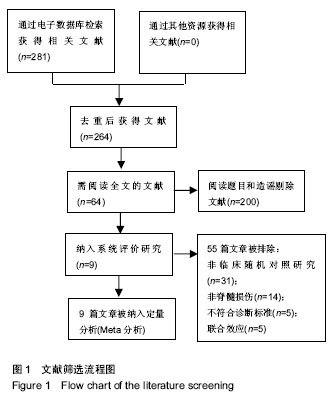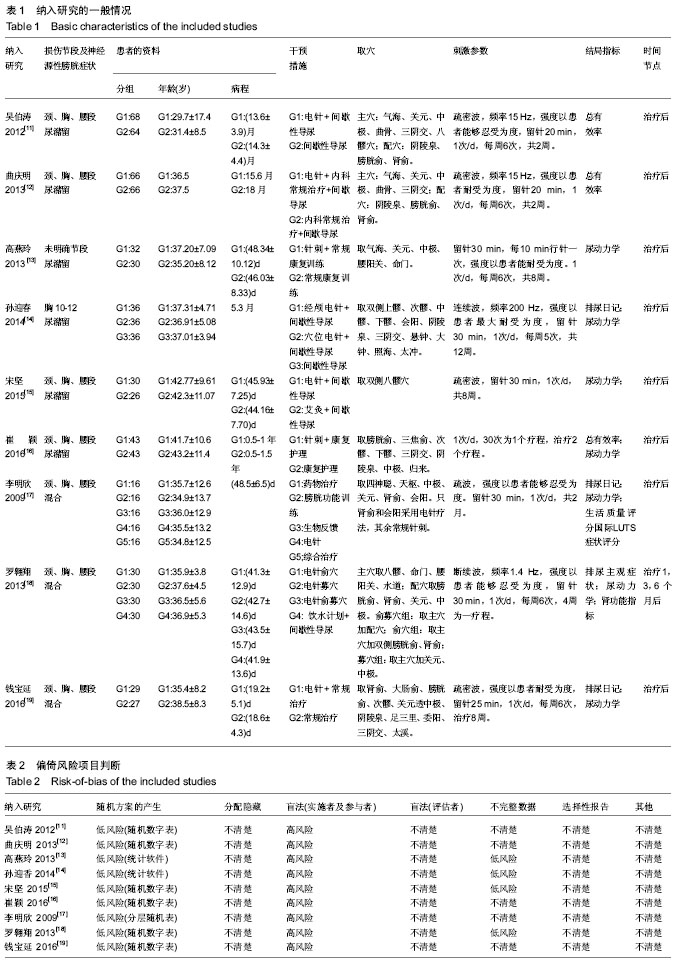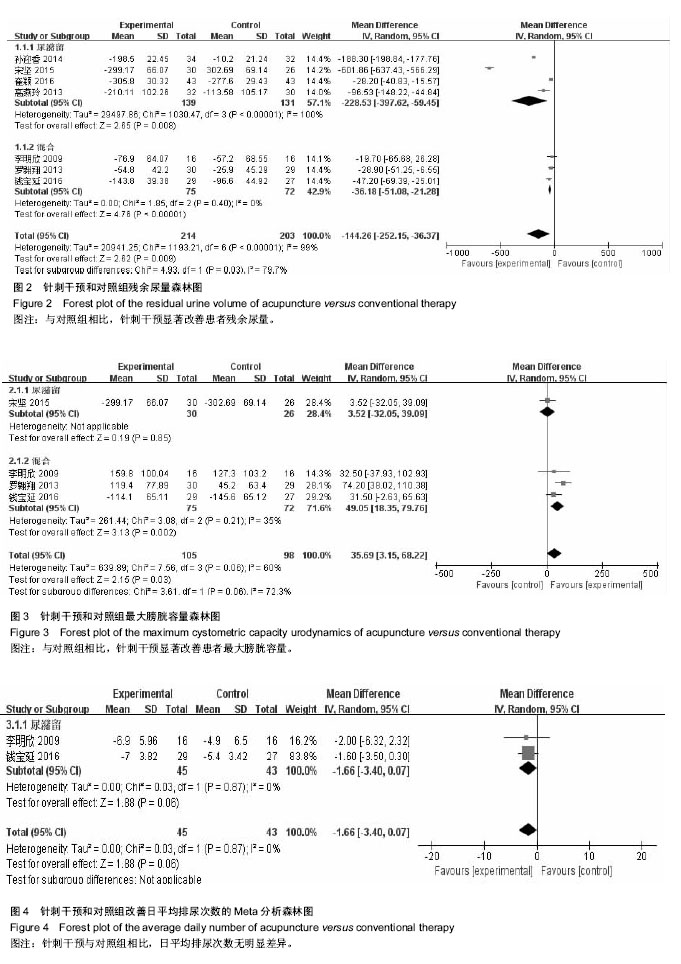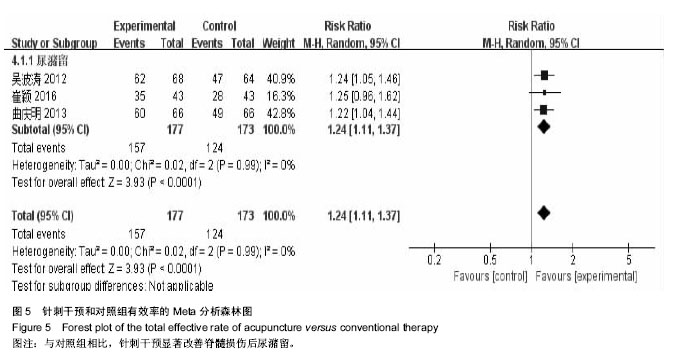中国组织工程研究 ›› 2018, Vol. 22 ›› Issue (12): 1962-1968.doi: 10.3969/j.issn.2095-4344.0214
• 组织构建循证医学 evidence-based medicine in tissue construction • 上一篇
针刺治疗脊髓损伤后尿潴留的Meta分析
程 洁1,郭佳宝2,陈炳霖3,朱 毅4
- 1南京中医药大学,江苏省南京市 210023;2上海体育学院,上海市 200438;3徐州医科大学,江苏省徐州市 221004;4海南医学院第二附属医院,海南省海口市 570100
Acupuncture treatment for urinary retention following spinal cord injury: a Meta-analysis
Cheng Jie1, Guo Jia-bao2, Chen Bing-lin3, Zhu Yi4
- 1Nanjing University of Chinese Medicine, Nanjing 210023, Jiangsu Province, China; 2Shanghai University of Sport, Shanghai 200438, China; 3Xuzhou Medical University, Xuzhou 221004, Jiangsu Province, China; 4the Second Affiliated Hospital of Hainan Medical University, Haikou 570100, Hainan Province, China
摘要:
文章快速阅读:
.jpg) 文题释义:
脊髓损伤后尿潴留:脊髓损伤后尿潴留的临床表现为患者排尿后膀胱留有明显的或者叩诊可及的残余尿,而膀胱无疼痛感,是脊髓损伤的主要并发症。脊髓损伤后尿潴留所致的尿路感染和肾功能衰竭,也是脊髓损伤患者死亡的重要原因之一。
神经源性膀胱:正常的排尿活动由脊髓反射中枢及交感、副交感、体神经共同参与,任何与排尿有关的神经受到损害后,引起的排尿功能障碍称为神经源性膀胱。是一类由神经病变或损害引起的膀胱和(或)尿道的功能障碍性疾病,常同时伴有膀胱尿道功能的协调性失常。神经源性膀胱尿道功能障碍产生复杂的排尿症状,排尿不畅或尿潴留是其中最常见的症状之一。
文题释义:
脊髓损伤后尿潴留:脊髓损伤后尿潴留的临床表现为患者排尿后膀胱留有明显的或者叩诊可及的残余尿,而膀胱无疼痛感,是脊髓损伤的主要并发症。脊髓损伤后尿潴留所致的尿路感染和肾功能衰竭,也是脊髓损伤患者死亡的重要原因之一。
神经源性膀胱:正常的排尿活动由脊髓反射中枢及交感、副交感、体神经共同参与,任何与排尿有关的神经受到损害后,引起的排尿功能障碍称为神经源性膀胱。是一类由神经病变或损害引起的膀胱和(或)尿道的功能障碍性疾病,常同时伴有膀胱尿道功能的协调性失常。神经源性膀胱尿道功能障碍产生复杂的排尿症状,排尿不畅或尿潴留是其中最常见的症状之一。
.jpg) 文题释义:
脊髓损伤后尿潴留:脊髓损伤后尿潴留的临床表现为患者排尿后膀胱留有明显的或者叩诊可及的残余尿,而膀胱无疼痛感,是脊髓损伤的主要并发症。脊髓损伤后尿潴留所致的尿路感染和肾功能衰竭,也是脊髓损伤患者死亡的重要原因之一。
神经源性膀胱:正常的排尿活动由脊髓反射中枢及交感、副交感、体神经共同参与,任何与排尿有关的神经受到损害后,引起的排尿功能障碍称为神经源性膀胱。是一类由神经病变或损害引起的膀胱和(或)尿道的功能障碍性疾病,常同时伴有膀胱尿道功能的协调性失常。神经源性膀胱尿道功能障碍产生复杂的排尿症状,排尿不畅或尿潴留是其中最常见的症状之一。
文题释义:
脊髓损伤后尿潴留:脊髓损伤后尿潴留的临床表现为患者排尿后膀胱留有明显的或者叩诊可及的残余尿,而膀胱无疼痛感,是脊髓损伤的主要并发症。脊髓损伤后尿潴留所致的尿路感染和肾功能衰竭,也是脊髓损伤患者死亡的重要原因之一。
神经源性膀胱:正常的排尿活动由脊髓反射中枢及交感、副交感、体神经共同参与,任何与排尿有关的神经受到损害后,引起的排尿功能障碍称为神经源性膀胱。是一类由神经病变或损害引起的膀胱和(或)尿道的功能障碍性疾病,常同时伴有膀胱尿道功能的协调性失常。神经源性膀胱尿道功能障碍产生复杂的排尿症状,排尿不畅或尿潴留是其中最常见的症状之一。摘要
背景:针刺是治疗脊髓损伤后尿潴留的常用方法,因其不良反应小、操作简便,被广泛应用于脊髓损伤后尿潴留的临床治疗中。但目前仍缺乏循证医学证据。
目的:对针刺治疗脊髓损伤后尿潴留的随机对照试验进行系统评价和Meta分析,以明确针刺干预的疗效。
方法:计算机检索中国生物医学、中国知网、万方、Cochrane Library、PubMed、EMBASE、Web of Science数据库,检索时间均从建库至2017年3月。中文检索词包括“脊髓损伤、尿潴留、针刺”;英文检索词包括“spinal cord injury, neurogenic bladder, acupuncture”。纳入针刺或针刺联合常规治疗与单纯常规治疗相比较的随机对照试验,采用RevMan 5.3 软件进行Meta分析。
结果与结论:①研究共纳入9个随机对照试验,632例患者;②Meta分析结果显示:在尿动力学方面,针刺治疗对患者残余尿量[MD=-144.26,95%CI(-252.15,-36.37),P=0.009]及最大膀胱容量[MD=35.69,95%CI(3.15,68.22),P=0.03]的改善效果均优于对照组,差异有显著性意义;③在排尿次数方面,针刺干预对患者日平均排尿次数的改善效果与对照组相比较,差异无显著性意义[MD=-1.66,95%CI(-3.40,0.07),P=0.06];④在总有效率方面,针刺干预脊髓损伤后神经源性膀胱患者的疗效优于对照组,差异有显著性意义[RR=1.24,95%CI(1.11,1.37),P < 0.0001];⑤结果提示:与常规治疗相比,针刺能更为有效地改善脊髓损伤后尿潴留患者的残余尿量、最大膀胱容量,提高治疗总有效率。
中国组织工程研究杂志出版内容重点:组织构建;骨细胞;软骨细胞;细胞培养;成纤维细胞;血管内皮细胞;骨质疏松;组织工程
ORCID: 0000-0002-7568-8669(程洁)
中图分类号:




.jpg) 文题释义:
脊髓损伤后尿潴留:脊髓损伤后尿潴留的临床表现为患者排尿后膀胱留有明显的或者叩诊可及的残余尿,而膀胱无疼痛感,是脊髓损伤的主要并发症。脊髓损伤后尿潴留所致的尿路感染和肾功能衰竭,也是脊髓损伤患者死亡的重要原因之一。
神经源性膀胱:正常的排尿活动由脊髓反射中枢及交感、副交感、体神经共同参与,任何与排尿有关的神经受到损害后,引起的排尿功能障碍称为神经源性膀胱。是一类由神经病变或损害引起的膀胱和(或)尿道的功能障碍性疾病,常同时伴有膀胱尿道功能的协调性失常。神经源性膀胱尿道功能障碍产生复杂的排尿症状,排尿不畅或尿潴留是其中最常见的症状之一。
文题释义:
脊髓损伤后尿潴留:脊髓损伤后尿潴留的临床表现为患者排尿后膀胱留有明显的或者叩诊可及的残余尿,而膀胱无疼痛感,是脊髓损伤的主要并发症。脊髓损伤后尿潴留所致的尿路感染和肾功能衰竭,也是脊髓损伤患者死亡的重要原因之一。
神经源性膀胱:正常的排尿活动由脊髓反射中枢及交感、副交感、体神经共同参与,任何与排尿有关的神经受到损害后,引起的排尿功能障碍称为神经源性膀胱。是一类由神经病变或损害引起的膀胱和(或)尿道的功能障碍性疾病,常同时伴有膀胱尿道功能的协调性失常。神经源性膀胱尿道功能障碍产生复杂的排尿症状,排尿不畅或尿潴留是其中最常见的症状之一。